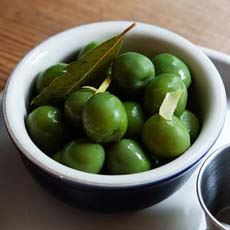Mellow & Magnificent Castelvetrano Olives: How To Enjoy Them
|
|
Olive connoisseurs love Castelvetrano olives (pronounced kah-stell-veh-TRAH-no). And more than a few people decide that they like olives after tasting the delicious, bright green fruit, named for a town* in the center of their growing region, the province of Trapani on the western side of Sicily.
The olives are so good that in a land of many olives, they’re Italy’s number one snack olive—selling three to one over any other type of olive. These bright green gems are often referred to as “dolce” olives, the word for “sweet” in Italian. The flavour is mild, subtly salty and delightfully sweet, lacking the bitterness found in most green olives. And the texture is a wonderfully robust combination of meaty, velvety and crisp. The olives are hand-harvested young (early in the season) and are cured in lightly salted brine, which accounts for their bright green color, firm, meaty texture and mellow, buttery flavor. Those who don’t like olives because they’ve only had stronger, brinier varieties may have found their olive. Some people say that Castelvetrano olives taste a bit like fine olive oil. That’s not surprising: Some of the finest olive oil comes from Castelvetrano olives (the oil is often called Noccellara—see footnote above). Castelvetranos debuted in the U.S. only in the last five years, starting in the olive bars of specialty food stores. They quickly became top-sellers. Mezzetta, one of our favorite brands (and the leading producer of glass-packed olives, peppers and specialty foods in the United States), was the first to offer them in jars in the U.S. If Castelvetrano olives are pricier than other olives, it’s because the trees have only a fair yield. But you get what you pay for: Mild and seductive, they’re olive bliss. We buy them by the case from Mezzetta’s online store. We go through a jar a week. Drinks, Appetizers & Cheese |
|
|
Salads While you can occasionally find pitted Castelvetrano olives, if not, just remove the olive pits with a cherry pitter. If you don’t have a pitter, crush the olives with the side of a chef’s knife and poke out the pits with a chopstick. Return the pitted olives to the jar of olive juice to maintain their bright color. When exposed to air for a long period of time, their brilliant color will begin to turn brownish. You can buy Castelvetrano olives online at Mezzetta.com. Use the search box to get to the two options: a single jar (16 ounces, $6.00) or a case (6 jars, $27.00—a 25% discount). Olives are a very healthy fruit. Some people avoid them because of their “high fat content.” But that’s the same incredibly heart-healthy, monounsaturated fat that we’re encouraged to consume via olive oil.† Olives have a trifecta of healthy components that work in synergy. In addition to the monounsaturated fats, olives are rich in the powerful antioxidant vitamin E–which neutralizes damaging free radicals–along with polyphenols and flavonoids, which have anti-inflammatory properties. As a bonus, olives are also rich in copper and iron, and are an excellent source of fiber. Snack on! > Discover more types of olives in our Olive & Olive Oil Glossary. > The history of olives. *The cultivar is actually Noccellara del Belice, named for the valley formed by the Belice River, which flows across the sunny, verdant island. †Monounsaturated fats have been found to reduce the risk of atherosclerosis and increase HDL (good) cholesterol.
|
||


